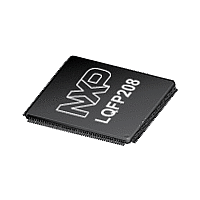LPC2939 NXP Semiconductors, LPC2939 Datasheet - Page 36

LPC2939
Manufacturer Part Number
LPC2939
Description
The LPC2939 combine an ARM968E-S CPU core with two integrated TCM blocksoperating at frequencies of up to 125 MHz, Full-speed USB 2
Manufacturer
NXP Semiconductors
Datasheet
1.LPC2939.pdf
(99 pages)
Available stocks
Company
Part Number
Manufacturer
Quantity
Price
Company:
Part Number:
LPC2939FBD208
Manufacturer:
NXP
Quantity:
105 000
Company:
Part Number:
LPC2939FBD208,551
Manufacturer:
NXP Semiconductors
Quantity:
10 000
Company:
Part Number:
LPC2939FET208,551
Manufacturer:
NXP Semiconductors
Quantity:
10 000
NXP Semiconductors
LPC2939_3
Product data sheet
6.13.4.2 Clock description
6.13.5.1 Functional description
6.13.5 Serial peripheral interface (SPI)
The UART modules are clocked by two different clocks; CLK_SYS_PESS and
CLK_UARTx (x = 0 to 1), see
CLK_UARTx branch clock for power management. The frequency of all CLK_UARTx
clocks is identical since they are derived from the same base clock BASE_CLK_UART.
The register interface towards the system bus is clocked by CLK_SYS_PESS. The baud
generator is clocked by the CLK_UARTx.
The LPC2939 contains three Serial Peripheral Interface modules (SPIs) to allow
synchronous serial communication with slave or master peripherals.
The key features are:
The SPI module can operate in:
The SPI module is a master or slave interface for synchronous serial communication with
peripheral devices that have either Motorola SPI or Texas Instruments Synchronous
Serial Interfaces.
The SPI module performs serial-to-parallel conversion on data received from a peripheral
device. The transmit and receive paths are buffered with FIFO memories (16 bits wide
32 words deep). Serial data is transmitted on pins SDOx and received on pins SDIx.
The SPI module includes a programmable bit-rate clock divider and prescaler to generate
the SPI serial clock from the input clock CLK_SPIx.
•
•
•
•
•
•
•
•
•
•
•
•
•
Master or slave operation
Each SPI supports up to four slaves in sequential multi-slave operation
Supports timer-triggered operation
Programmable clock bit rate and prescale based on SPI source clock
(BASE_SPI_CLK), independent of system clock
Separate transmit and receive FIFO memory buffers; 16 bits wide, 32 locations deep
Programmable choice of interface operation: Motorola SPI or Texas Instruments
Synchronous Serial Interfaces
Programmable data-frame size from 4 to 16 bits
Independent masking of transmit FIFO, receive FIFO and receive overrun interrupts
Serial clock-rate master mode: fserial_clk f
Serial clock-rate slave mode: fserial_clk = f
Internal loopback test mode
Master mode:
– Normal transmission mode
– Sequential slave mode
Slave mode
All information provided in this document is subject to legal disclaimers.
Rev. 03 — 7 April 2010
Section
6.7.2. Note that each UART has its own
ARM9 microcontroller with CAN, LIN, and USB
clk(SPI)
clk(SPI)
/ 4
/ 2
LPC2939
© NXP B.V. 2010. All rights reserved.
36 of 99
















